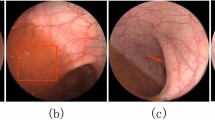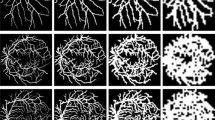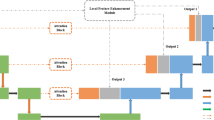Abstract
Purpose
Precise segmentation of intestinal wall vessels is vital to colonic perforation prevention. However, there are interferences such as gastric juice in the vessel image of the intestinal wall, especially vessels and the mucosal folds are difficult to distinguish, which easily lead to mis-segmentation. In addition, the insufficient feature extraction of intricate vessel structures may leave out information of tiny vessels that result in rupture. To overcome these challenges, an effective network is proposed for segmentation of intestinal wall vessels.
Methods
A global context attention network (GCA-Net) that employs a multi-scale fusion attention (MFA) module is proposed to adaptively integrate local and global context information to improve the distinguishability of mucosal folds and vessels, more importantly, the ability to capture tiny vessels. Also, a parallel decoder is used to introduce a contour loss function to solve the blurry and noisy blood vessel boundaries.
Results
Extensive experimental results demonstrate the superiority of the GCA-Net, with accuracy of 94.84%, specificity of 97.89%, F1-score of 73.80%, AUC of 96.30%, and MeanIOU of 76.46% in fivefold cross-validation, exceeding the comparison methods. In addition, the public dataset DRIVE is used to verify the potential of GCA-Net in retinal vessel image segmentation.
Conclusion
A novel network for segmentation of intestinal wall vessels is developed, which can suppress interferences in intestinal wall vessel images, improve the discernibility of blood vessels and mucosal folds, enhance vessel boundaries, and capture tiny vessels. Comprehensive experiments prove that the proposed GCA-Net can accurately segment the intestinal wall vessels.






Similar content being viewed by others
References
Jung Y (2020) Endoscopic management of iatrogenic colon perforation. Clin Endosc 53(1):29
Arora G, Mannalithara A, Singh G, Gerson LB, Triadafilopoulos G (2009) Risk of perforation from a colonoscopy in adults: a large population-based study. Gastrointest Endosc 69(3):654–664
Zheng C, Qian Z, Zhou K, Liu H, Lv D, Zhang W (2017) A novel sensor for real-time measurement of force and torque of colonoscope. In IECON 2017-43rd Annual Conference of the IEEE Industrial Electronics Society. IEEE, pp 3265–3269
Cheng WB, Moser MA, Kanagaratnam S, Zhang WJ (2012) Overview of upcoming advances in colonoscopy. Dig Endosc 24(1):1–6
Johnson S, Schultz M, Scholze M, Smith T, Woodfield J, Hammer N (2019) How much force is required to perforate a colon during colonoscopy? an experimental study. J Mech Behav Biomed Mater 91:139–148
Li Y, Gong H, Wu W, Liu G, Chen G (2015) An automated method using hessian matrix and random walks for retinal blood vessel segmentation. In 2015 8th International Congress on Image and Signal Processing (CISP). IEEE, pp 423–427
Soares JV, Leandro JJ, Cesar RM, Jelinek HF, Cree MJ (2006) Retinal vessel segmentation using the 2-d gabor wavelet and supervised classification. IEEE Trans Med Imaging 25(9):1214–1222
Nguyen UT, Bhuiyan A, Park LA, Ramamohanarao K (2013) An effective retinal blood vessel segmentation method using multi-scale line detection. Pattern Recognit 46(3):703–715
Goceri E (2016) Automatic labeling of portal and hepatic veins from mr images prior to liver transplantation. Int J Comput Assist Radiol Surg 11(12):2153–2161
Foruzan AH, Zoroofi RA, Sato Y, Hori M (2012) A hessian-based filter for vascular segmentation of noisy hepatic ct scans. Int J Comput Assist Radiol Surgery 7(2):199–205
Ronneberger O, Fischer P, Brox T (2015) U-net: Convolutional networks for biomedical image segmentation. In International Conference on Medical image computing and computer-assisted intervention. Springer, pp 234–241
Li L, Verma M, Nakashima Y, Nagahara H, Kawasaki R (2020) Iternet: Retinal image segmentation utilizing structural redundancy in vessel networks. In Proceedings of the IEEE/CVF Winter Conference on Applications of Computer Vision, pp 3656–3665
Wang K, Zhang X, Huang S, Wang Q, Chen F (2020) Ctf-net: Retinal vessel segmentation via deep coarse-to-fine supervision network. In 2020 IEEE 17th International Symposium on Biomedical Imaging (ISBI). IEEE, pp 1237–1241
Gu Z, Cheng J, Fu H, Zhou K, Hao H, Zhao Y, Zhang T, Gao S, Liu J (2019) Ce-net: Context encoder network for 2d medical image segmentation. IEEE Trans Med Imaging 38(10):2281–2292
Samuel PM, Veeramalai T (2019) Multilevel and multiscale deep neural network for retinal blood vessel segmentation. Symmetry 11(7):946
Mo J, Zhang L (2017) Multi-level deep supervised networks for retinal vessel segmentation. Int J Comput Assist Radiol Surg 12(12):2181–2193
Li X, Jiang Y, Li M, Yin S (2020) Lightweight attention convolutional neural network for retinal vessel image segmentation. IEEE Trans Ind Inf 17(3):1958–1967
Feng S, Zhao H, Shi F, Cheng X, Wang M, Ma Y, Xiang D, Zhu W, Chen X (2020) Cpfnet: Context pyramid fusion network for medical image segmentation. IEEE Trans Med Imaging 39(10):3008–3018
Tan T, Wang Z, Du H, Xu J, Qiu B (2021) Lightweight pyramid network with spatial attention mechanism for accurate retinal vessel segmentation. Int J Comput Assist Radiol Surg 16(4):673–682
Mou L, Zhao Y, Chen L, Cheng J, Gu Z, Hao H, Qi H, Zheng Y, Frangi A, Liu J (2019) Cs-net: channel and spatial attention network for curvilinear structure segmentation. In International Conference on Medical Image Computing and Computer-Assisted Intervention. Springer, pp 721–730
He K, Zhang X, Ren S, Sun J (2016) Deep residual learning for image recognition. In Proceedings of the IEEE conference on computer vision and pattern recognition, pp 770–778
Goceri E (2019) Analysis of deep networks with residual blocks and different activation functions: classification of skin diseases. In 2019 Ninth international conference on image processing theory, tools and applications (IPTA). IEEE, pp 1–6
Yu Y, Adu K, Tashi N, Anokye P, Wang X, Ayidzoe MA (2020) Rmaf: Relu-memristor-like activation function for deep learning. IEEE Access 8:72727–72741
Goceri E (2021) Diagnosis of skin diseases in the era of deep learning and mobile technology. Comput Biol Med 134:104458
Tanaka M (2020) Weighted sigmoid gate unit for an activation function of deep neural network. Pattern Recognit Lett 135:354–359
Goceri E (2021) Deep learning based classification of facial dermatological disorders. Comput Biol Med 128:104118
EvginGoceri (2019) Skin disease diagnosis from photographs using deep learning. In ECCOMAS Thematic Conference on Computational Vision and Medical Image Processing
Crum WR, Camara O, Hill DL (2006) Generalized overlap measures for evaluation and validation in medical image analysis. IEEE Trans Med Imaging 25(11):1451–1461
Milletari F, Navab N, Ahmadi S-A (2016) V-net: Fully convolutional neural networks for volumetric medical image segmentation. In 2016 fourth international conference on 3D vision (3DV). IEEE, pp 565–571
Sudre CH, Li W, Vercauteren T, Ourselin S, Cardoso MJ (2017) Generalised dice overlap as a deep learning loss function for highly unbalanced segmentations. In Deep learning in medical image analysis and multimodal learning for clinical decision support. Springer, pp 240–248
Kervadec H, Dolz J, Yuan J, Desrosiers C, Granger E, Ayed IB (2019) Constrained deep networks: Lagrangian optimization via log-barrier extensions, arXiv preprint arXiv:1904.04205
Goceri E (2020) Capsnet topology to classify tumours from brain images and comparative evaluation. IET Image Process 14(5):882–889
López-González FJ, Silva-Rodríguez J, Paredes-Pacheco J, Niñerola-Baizán A, Efthimiou N, Martín-Martín C, Moscoso A, Ruibal Á, Roé-Vellvé N, Aguiar P (2020) Intensity normalization methods in brain fdg-pet quantification. Neuroimage 222:117229
Goceri E (2018) Fully automated and adaptive intensity normalization using statistical features for brain mr images. Celal Bayar Univ J Sci 14(1):125–134
Chang YH, Chin K, Thibault G, Eng J, Burlingame E, Gray JW (2020) Restore: Robust intensity normalization method for multiplexed imaging. Commun Biol 3(1):1–9
Goceri E (2017) Intensity normalization in brain mr images using spatially varying distribution matching. In: 11th International Conference on computer graphics, visualization, computer vision and image processing (CGVCVIP 2017), pp 300–4
Funding
This work was supported by National Science Foundation of P.R. China (Grants: 61873239) and Key R& D Program Projects in Zhejiang Province (Grant: 2020C03074).
Author information
Authors and Affiliations
Corresponding author
Ethics declarations
Conflict of Interest
The authors declare that they have no conflict of interest.
Ethical Approval
This article does not contain any studies with human participants or animals performed by any of the authors.
Informed consent
This articles does not contain patient data.
Additional information
Publisher's Note
Springer Nature remains neutral with regard to jurisdictional claims in published maps and institutional affiliations.
Rights and permissions
About this article
Cite this article
Li, S., Kong, X., Lu, C. et al. GCA-Net: global context attention network for intestinal wall vascular segmentation. Int J CARS 17, 569–578 (2022). https://doi.org/10.1007/s11548-021-02506-x
Received:
Accepted:
Published:
Issue Date:
DOI: https://doi.org/10.1007/s11548-021-02506-x




